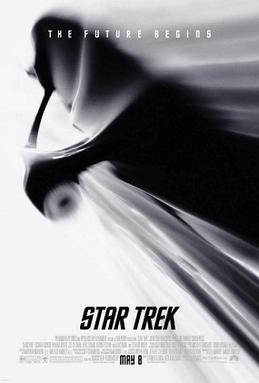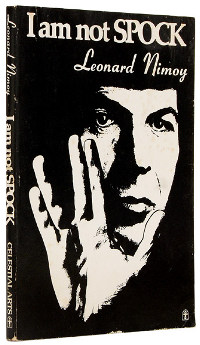
Vulcans, sometimes referred to as Vulcanians, are a fictional extraterrestrial humanoid species in the Star Trek universe and media franchise. In the various Star Trek television series and films, they are noted for their attempt to live by logic and reason with as little interference from emotion as possible. Known for their pronounced eyebrows and pointed ears, they originate from the fictional planet Vulcan. In the Star Trek universe, they were the first extraterrestrial species to make contact with humans.

Leonard Simon Nimoy was an American actor and director, famed for playing Spock in the Star Trek franchise for almost 50 years. This includes originating Spock in the original Star Trek series in 1966, then Star Trek: The Animated Series, the first six Star Trek films, Star Trek: The Next Generation, Star Trek, and Star Trek Into Darkness. Nimoy also directed films, including Star Trek III: The Search for Spock (1984), Star Trek IV: The Voyage Home (1986), and Three Men and a Baby (1987), and appeared in several films, television shows, and voice acted in several video games. Outside of acting, Nimoy was a film director, photographer, author, singer, and songwriter.

Spock is a fictional character in the Star Trek media franchise. He first appeared in the original Star Trek series serving aboard the starship USS Enterprise as science officer and first officer and later as commanding officer of the vessel. Spock's mixed human–Vulcan heritage serves as an important plot element in many of the character's appearances. Along with Captain James T. Kirk and Dr. Leonard "Bones" McCoy, he is one of the three central characters in the original Star Trek series and its films. After retiring from active duty in Starfleet, Spock served as a Federation ambassador, and later became involved in the ill-fated attempt to save Romulus from a supernova, leading him to live out the rest of his life in a parallel universe.

Star Trek IV: The Voyage Home is a 1986 American science fiction film, the fourth installment in the Star Trek film franchise based on the television series Star Trek. The second film directed by Leonard Nimoy, it completes the story arc begun in Star Trek II: The Wrath of Khan (1982), and continued in Star Trek III: The Search for Spock (1984). Intent on returning home to Earth to face trial for their actions in the previous film, the former crew of the USS Enterprise finds the planet in grave danger from an alien probe attempting to contact now-extinct humpback whales. The crew travel to Earth's past to find whales who can answer the probe's call.

Star Trek III: The Search for Spock is a 1984 American science fiction film, written and produced by Harve Bennett, directed by Leonard Nimoy, and based on the television series Star Trek. It is the third film in the Star Trek franchise and is the second part of a three-film story arc that begins with Star Trek II: The Wrath of Khan (1982) and concludes with Star Trek IV: The Voyage Home (1986). After the death of Spock (Nimoy), the crew of the USS Enterprise return to Earth. When James T. Kirk learns that Spock's spirit, or katra, is held in the mind of Dr. Leonard "Bones" McCoy, Kirk and company steal the decommissioned USS Enterprise to return Spock's body to his homeworld. The crew must also contend with hostile Klingons, led by Kruge, who are bent on stealing the secrets of the powerful terraforming device, Genesis.

Saavik is a fictional character in the Star Trek universe. She first appeared in the film Star Trek II: The Wrath of Khan (1982) played by Kirstie Alley. Robin Curtis took over the role for Star Trek III: The Search for Spock (1984) and Star Trek IV: The Voyage Home (1986).

Christine Chapel is a fictional character who appears in all three seasons of the American science fiction television series Star Trek: The Original Series, as well as Star Trek: The Animated Series and the films Star Trek: The Motion Picture and Star Trek IV: The Voyage Home. Portrayed by Majel Barrett, she was the ship's nurse on board the Starfleet starship USS Enterprise. A younger version of Chapel appears in the 2022 series Star Trek: Strange New Worlds, portrayed by Jess Bush.

"Unification" is a two-part episode of the syndicated American science fiction television series Star Trek: The Next Generation which features Leonard Nimoy as Spock. The first of the two episodes earned a 15.4 household Nielsen rating, drawing over 25 million viewers, making it one of the most watched episodes in all seven seasons of The Next Generation's run.

The Vulcan salute is a hand gesture popularized by the 1960s television series Star Trek. It consists of a raised hand with the palm forward and the thumb extended, while the fingers are parted between the middle and ring finger. The gesture was devised by Star Trek actor Leonard Nimoy as a salute for the alien Vulcan species, and is popular within the Science fiction fandom and nerd culture. The blessing phrase "live long and prosper" is frequently spoken alongside it.

In the fictional Star Trek universe, the Vulcan nerve pinch is a fictional technique used mainly by Vulcans to render unconsciousness by pinching a pressure point at the base of the victim's neck.

The discography of American actor Leonard Nimoy consists of SEE BELOW.

Star Trek is a 2009 American science fiction action film directed by J. J. Abrams and written by Roberto Orci and Alex Kurtzman. It is the 11th film in the Star Trek franchise, and is also a reboot that features the main characters of the original Star Trek television series portrayed by a new cast, as the first in the rebooted film series. The film follows James T. Kirk and Spock aboard the USS Enterprise as they combat Nero, a Romulan from their future who threatens the United Federation of Planets. The story takes place in an alternate reality that features both an alternate birth location for James T. Kirk and further alterations in history stemming from the time travel of both Nero and the original series Spock. The alternate reality was created in an attempt to free the film and the franchise from established continuity constraints while simultaneously preserving original story elements.

Adam B. Nimoy is an American television director. He is the son of actors Leonard Nimoy and Sandra Zober.

I Am Not Spock is Leonard Nimoy's first autobiography. Published in 1975, between the end of Star Trek: The Animated Series and the production of Star Trek: The Motion Picture, the book was criticized by some fans because of the perception that Nimoy was rejecting the character Spock. He maintained he was only clarifying the difference between himself and Spock, whom he always enjoyed playing. However, he later published I Am Spock in an attempt to address the misconceptions.
Alien Voices was a project set up by John de Lancie and Leonard Nimoy which specialized in audiobooks of science fiction novels in the style of radio plays. The productions were distributed by Simon & Schuster Audio, but the project was shut down following pressure from the distributor for greater sales and the dissatisfaction of de Lancie and Nimoy at this direction. The productions featured a number of cast members from the various Star Trek series. Digital editions of the plays were released in 2012.

Mind Meld: Secrets Behind the Voyage of a Lifetime is a 2001 American documentary film in which actors William Shatner and Leonard Nimoy discuss the Star Trek science fiction franchise and its effects on their lives. Shatner and Nimoy portrayed the characters James T. Kirk and Spock respectively in the 1960s Star Trek television series, the 1970s animated television series, and their film sequels.

For the Love of Spock is a 2016 American documentary film about actor Leonard Nimoy produced by 455 Films and directed by his son Adam Nimoy, who started it before his father's death, at the age of 83, on February 27, 2015.

The development of Spock, a fictional character first introduced in the American science fiction television series Star Trek, began prior to the start of the series. The first known mention of Spock was in a discussion between Gene Roddenberry and Gary Lockwood, where the latter suggested Leonard Nimoy for the role. Roddenberry agreed with the suggestion, and Nimoy became the first choice actor for the part. However, Roddenberry was required to audition other actors for the role. It was offered to both DeForest Kelley and Martin Landau before Nimoy. Nimoy disliked the prosthetic ears he was required to wear, and there were concerns from the studio that they made him appear satanic. Roddenberry fought to keep the character in the second pilot, "Where No Man Has Gone Before" after the rest of the main cast was dropped from the initial pilot, "The Cage".

Leonard Nimoy was an American actor who had a career in film and television for seven decades. Nimoy's breakthrough role was his portrayal of Spock in Star Trek.


















